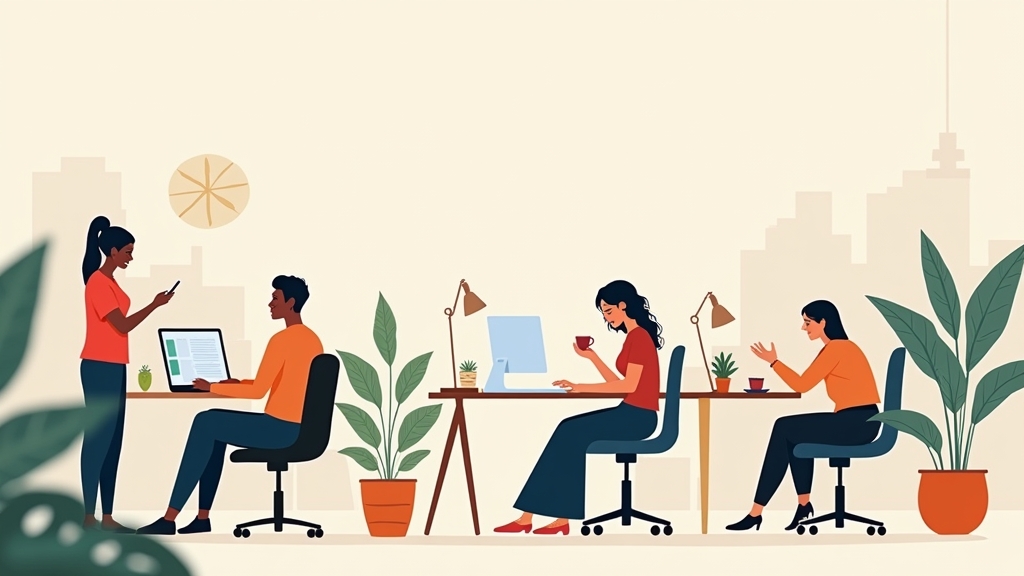Advertising
The Influence of the "Slow Work" Culture on Reducing Burnout and Redefining Productivity
Have you ever felt that work takes up more than just your hours in the office? The pressure for immediate results, the demand for constant productivity and the "always on" culture have led millions of professionals to burnout. But what if there was a way to work with more purpose, less stress and still achieve significant results? This is where slow worka movement that is transforming the relationship between work and well-being.
In this article, we'll explore how this philosophy can reduce burnout, redefine what it means to be productive and create healthier work environments. We'll dive into real examples, convincing data and practical strategies for applying these principles in your day-to-day life. Get ready to rethink everything you know about productivity.
What is the Slow Work Movement and How Did It Come About?
O slow work is not just a passing fad - it's a direct response to the excesses of modern corporate culture. Inspired by the slow foodwhich values quality and process over speed, the slow work proposes a more conscious and sustainable approach to work. But how does this translate into practice?
Imagine a day when you don't have to rush from meeting to meeting, answer emails at all hours or feel guilty about taking a break. Instead, you prioritize meaningful tasks, take time to think deeply and set clear boundaries between work and personal life. Companies like Basecamp have already adopted this model, with more flexible working hours and a focus on results rather than overtime.
The concept gained momentum after the pandemic, when many people realized that the unsustainable pace of remote (or hybrid) work only increased stress. Studies show that 76% of professionals suffer from burnout at some point in their careeraccording to World Health Organization. O slow work has emerged as an alternative for balancing efficiency and mental health.
But does this approach work in all sectors? The answer is yes, with adaptations. From startups to traditional corporations, companies are discovering that slowing down can paradoxically accelerate innovation. When employees have room to breathe, creativity flows, mistakes decrease and engagement increases.
The Relationship Between Burnout and the Culture of Haste
Why do so many professionals reach their physical and emotional limits? Burnout is not simply "being tired" - it's a chronic state of exhaustion, often accompanied by cynicism and reduced professional effectiveness. And guess what one of the main culprits is? The glorification of running.
In many environments, being productive has become synonymous with working longer hours, answering messages at midnight and giving up vacations. A report by Gallup reveals that employees who feel overloaded have 2.6 times more likely to look for another job. The cost? Companies lose talent and professionals lose years of health.
Take the case of Ana, a marketing manager who worked 12 hours a day. She thought she was in control until she started having anxiety attacks. "I realized that my productivity was an illusion. I was doing a lot, but nothing with quality," she says. By adopting slow workBy blocking out times for important tasks and turning off notifications after work, she recovered not only her performance, but also her well-being.
And it's not just individuals who suffer. Companies with toxic cultures of overwork face absenteeism, presenteeism (when the employee is at work but not producing) and sky-high health costs. Burnout costs the global economy US$ 322 billion per yearaccording to the Harvard Business Review.
The question that remains is: is it worth sacrificing people on the altar of productivity? O slow work shows that there is a better - and more profitable - way.
How Slow Work Redefines the Concept of Productivity
If you think productivity means doing more in less time, get ready for a revolution in thinking. O slow work proposes that real productivity is linked to impact, not volume. In other words, it doesn't matter how many tasks you cross off the list, but which ones actually move the needle.
Think of a software developer. He can code for 10 hours straight, but if he's exhausted, the bugs will increase. Now imagine him working 6 focused hours, with strategic breaks. The result? Cleaner code, less rework and a satisfied professional. Companies like Microsoft have already tested the 4-day week and seen productivity to go up 40%according to BBC.
Another pillar of slow work is the deep work (deep work), a concept popularized by Cal Newport. It's about dedicating uninterrupted blocks of time to complex tasks, rather than jumping between demands. A study by American Psychological Association shows that multitasking reduces productivity by up to 40%.
But how do you apply this in your daily life? Start by identifying your "high impact tasks" - those that generate the most value. Set aside specific times for them, eliminate distractions (yes, that includes WhatsApp) and allow yourself to rest between cycles. You may be surprised to discover that working fewer hours delivers more results.
Practical Strategies for Implementing Slow Work
Now that you understand the benefits, how to put the slow work in practice? It's not about working less, it's about working better. Here are some strategies tried and tested by companies and professionals who have already adopted this philosophy.
First, evaluate your current workflow. How many meetings could be emails? How many tasks are occupations, not priorities? Tools such as RescueTime help you identify where your time is being spent - and where it is being wasted.
Second, set clear boundaries. This includes fixed times to start and end the day, as well as communicating your availability to the team. The "always online" culture is one of the biggest causes of burnout. If you work remotely, create a ritual to mark the end of working hours, such as going for a walk or turning off your computer.

Third, make room for creative leisure. Great ideas often arise when the mind is relaxed. Companies like 3M and Google encourage employees to devote time to personal projects - that's how innovations like Post-it and Gmail came about.
Finally, try the Pomodoro technique. Work for 25 minutes focused, rest for 5. Every four cycles, take a longer break. It sounds simple, but this alternation between concentration and rest can dramatically increase your efficiency.
The Role of Leadership in Adopting Slow Work
There's no point in employees wanting to change if the leadership still values overtime and 24/7 availability. The transformation to a culture slow work starts at the top.
Leaders who adopt this mindset understand that rested employees are more creative, loyal and productive. They promote shorter meetings (or eliminate them when possible), set realistic expectations and give people autonomy to manage their own rhythms.
One example is Spotify, which has implemented "Work From Anywhere" - employees can choose where and when they work, as long as they deliver results. Another case is Zapposwhich abolished artificial deadlines in favor of a more organic environment.
But what about traditional companies? Small changes can already make a difference. How about starting by encouraging real lunch breaks, reducing unnecessary meetings or creating "right to disconnect" policies?
Leaders also need to model behavior. If the CEO sends emails at midnight, the team feels they need to do the same. Culture is created through actions, not just speeches.
The Impacts of Slow Work on Mental Health and Engagement
The benefits of slow work go far beyond productivity. They are reflected in higher levels of satisfaction, mental health and talent retention.
A study by Forbes showed that companies with welfare policies have 21% more profitability. Employees who don't live on the edge are more engaged, make fewer mistakes and contribute to a positive environment.
In practice, this means less sick leave due to stress, less turnover and a team that really wants to be there. Would you rather have an exhausted employee who keeps to a schedule or a motivated one who brings solutions?
In addition, the slow work reduces presenteeism - when a professional is at work but can't perform due to burnout. According to CDCThis costs companies US$ 1,500 per employee per year.
And the effects extend beyond the office. People with more balance are better partners, parents and friends. They have energy for hobbies, exercise and a social life - things that, in the end, make them even better professionals.
How to Start Your Transition to Slow Work Today
You don't have to wait for your company to change to adopt slow work. Small adjustments to your routine can already bring big results.
Get started auditing your time. Write down everything you do in a week and identify patterns. Which tasks consume energy without generating value? Which times of the day are you most productive?
Then, try saying "no". Not every urgent demand is important. Learning to prioritize is essential to avoid the trap of "doing too much and accomplishing too little".
Another tip is negotiate realistic deadlines. Instead of accepting a project for "yesterday", ask: "What is the real deadline? Can I deliver in stages?" Pressures are often imaginary.
Finally, invest in self-care. Sleep, food and exercise are not luxuries - they are fuel for quality work. You can't do your best if you're operating on reserve.
O slow work it's not about working slowly, it's about working with purpose. Are you ready to rethink your relationship with work?
This article was written to inspire real change. How about sharing these ideas with your team or leader? The future of work has already begun - and it's more humane, sustainable and, yes, productive.



